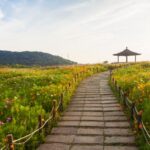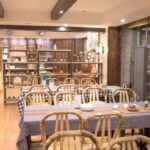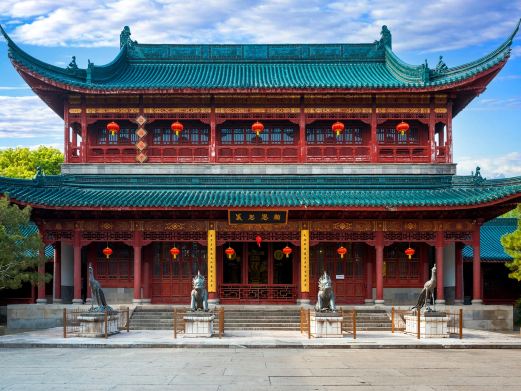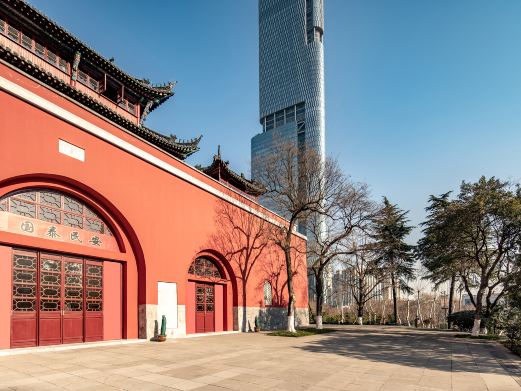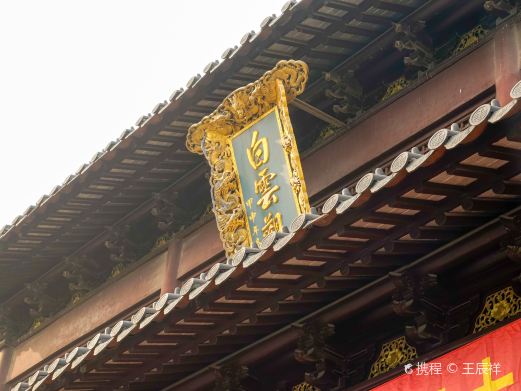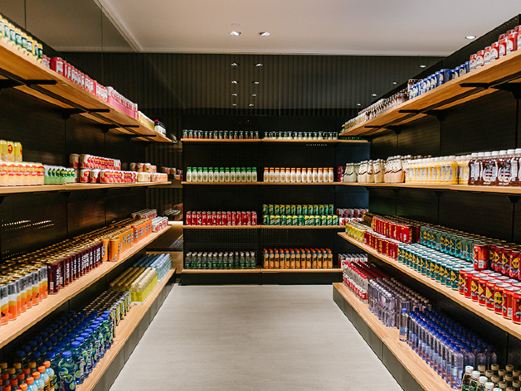Asoka Temple is more than 20 kilometers away from the center of Ningbo City. It is a temple named after Asoka of India. Because it enshrines Buddhist relics, it has a high status in the Buddhist community. The Buddhist atmosphere of the temple is pure. There are few tourist groups. Only devout pilgrims and leisurely monks can be seen. Walking among them, you can even hear the rustling sound of fallen leaves. The history of Asoka Temple can be traced back to the Jin Dynasty. The entire temple is simple and solemn, with a complete structure. The halls and temples are integrated with the vast mountain scenery. After entering the mountain gate, the main scenic spots are all located in the middle of the temple. From bottom to top, there are Yule Pond, Heavenly King Hall, Mahavira Hall, Relic Hall and Sutra Depository in sequence. On both sides of these halls are also distributed Yunshui Hall, Chengen Hall, Abbot’s Hall, Bell Tower, Hall of Five Hundred Arhats, Xianjue Hall, Dabei Pavilion and other buildings. Generally, tourists will mainly visit the Heavenly King Hall, Mahavira Hall, Relic Hall and Hall of Five Hundred Arhats. In front of the Heavenly King Hall is a Yule Pond, which contains many small fish and turtles. However, because there are too many of them, tourists are prohibited from releasing living creatures here. Inside the hall, Maitreya Buddha is enshrined, and on both sides are the Four Heavenly Kings. Behind the Heavenly King Hall is the Mahavira Hall. Inside the hall, the statue of Sakyamuni Buddha is enshrined. On the east side are the statues of Bhaisajyaguru Buddha and Ananda. On the west side are Amitabha Buddha and Kassapa. Tourists can take incense and worship in front of these two halls by themselves. After leaving the Mahavira Hall, you can visit the Relic Hall. The roof is covered with golden glazed tiles. In the middle of the hall is a seven-meter-high stone tower. Inside is a niche inlaid with seven treasures, which contains Buddhist relics. Under the stone tower are the statues of Libin and Asoka. Behind the stone tower is also placed a reclining statue of Sakyamuni Buddha, about four meters long. However, generally tourists can hardly see the Buddhist relics because advance application is required for visiting. After visiting the Relic Hall, you can directly go to the Hall of Five Hundred Arhats, where 500 vivid and different arhats are enshrined. After visiting these main halls, you can also see the two towers currently well-preserved in the temple. One is called the West Tower (commonly known as the Lower Tower), and the other is called the East Tower, which was built later. Neither tower can be climbed. But according to the locals, you can walk around clockwise under the tower. It is said that it can wash away your bad luck. In addition, there is also an upper tower on the mountain, but it has been damaged due to long years. In addition, Buddhist traces, Lisheng Pavilion, core stone of tower foundation, breast milk spring, Banshan Pavilion, Eight Auspicious Places, Jianzhen Memorial Pavilion and other places are also important historical sites in the temple. You can take photos as souvenirs if you pass by. There is a place to eat vegetarian food at the entrance of the temple. A set meal is basically about 50 yuan, and vegetarian noodles are 25 yuan. Asoka Temple is not far from Tiantong Temple. You can drive by yourself or take Bus No. 162 at the temple gate to get there. If you have time, you can visit them together.
Opening hours: Open from 07:00 to 16:00 all year round.


